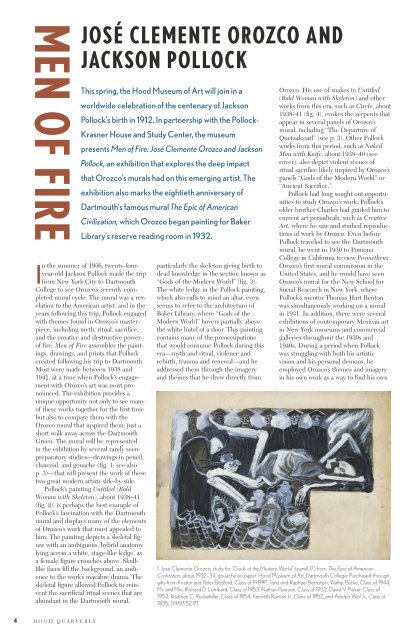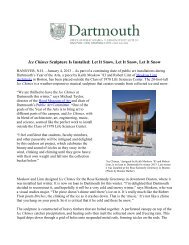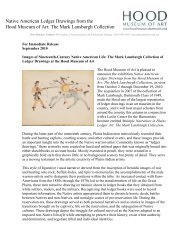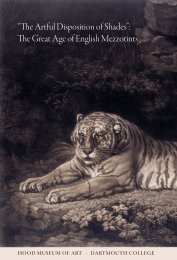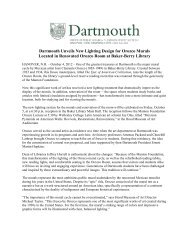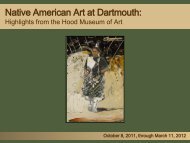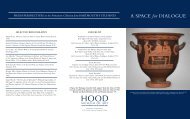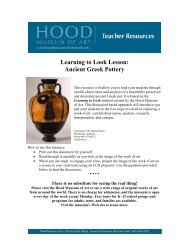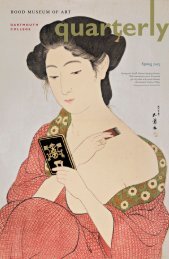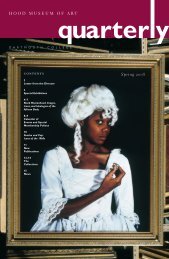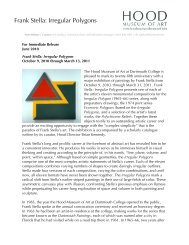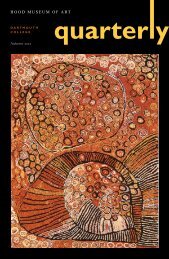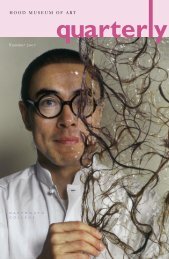Spring 2012 - Hood Museum of Art - Dartmouth College
Spring 2012 - Hood Museum of Art - Dartmouth College
Spring 2012 - Hood Museum of Art - Dartmouth College
Create successful ePaper yourself
Turn your PDF publications into a flip-book with our unique Google optimized e-Paper software.
MEN OF FIRE<br />
JOSÉ CLEMENTE OROZCO AND<br />
JACKSON POLLOCK<br />
This spring, the <strong>Hood</strong> <strong>Museum</strong> <strong>of</strong> <strong>Art</strong> will join in a<br />
worldwide celebration <strong>of</strong> the centenary <strong>of</strong> Jackson<br />
Pollock’s birth in 1912. In partnership with the Pollock-<br />
Krasner House and Study Center, the museum<br />
presents Men <strong>of</strong> Fire: José Clemente Orozco and Jackson<br />
Pollock, an exhibition that explores the deep impact<br />
that Orozco’s murals had on this emerging artist. The<br />
exhibition also marks the eightieth anniversary <strong>of</strong><br />
<strong>Dartmouth</strong>’s famous mural The Epic <strong>of</strong> American<br />
Civilization, which Orozco began painting for Baker<br />
Library’s reserve reading room in 1932.<br />
In the summer <strong>of</strong> 1936, twenty-fouryear-old<br />
Jackson Pollock made the trip<br />
from New York City to <strong>Dartmouth</strong><br />
<strong>College</strong> to see Orozco’s recently completed<br />
mural cycle. The mural was a revelation<br />
to the American artist, and in the<br />
years following this trip, Pollock engaged<br />
with themes found in Orozco’s masterpiece,<br />
including myth, ritual, sacrifice,<br />
and the creative and destructive power<br />
<strong>of</strong> fire. Men <strong>of</strong> Fire assembles the paintings,<br />
drawings, and prints that Pollock<br />
created following his trip to <strong>Dartmouth</strong>.<br />
Most were made between 1938 and<br />
1941, at a time when Pollock’s engagement<br />
with Orozco’s art was most pronounced.<br />
The exhibition provides a<br />
unique opportunity not only to see many<br />
<strong>of</strong> these works together for the first time<br />
but also to compare them with the<br />
Orozco mural that inspired them, just a<br />
short walk away across the <strong>Dartmouth</strong><br />
Green. The mural will be represented<br />
in the exhibition by several rarely seenpreparatory<br />
studies—drawings in pencil,<br />
charcoal, and gouache (fig. 1; see also<br />
p. 3)—that will present the work <strong>of</strong> these<br />
two great modern artists side-by-side.<br />
Pollock’s painting Untitled (Bald<br />
Woman with Skeleton), about 1938–41<br />
(fig. 2), is perhaps the best example <strong>of</strong><br />
Pollock’s fascination with the <strong>Dartmouth</strong><br />
mural and displays many <strong>of</strong> the elements<br />
<strong>of</strong> Orozco’s work that most appealed to<br />
him. The painting depicts a skeletal figure<br />
with an ambiguous, hybrid anatomy<br />
lying across a white, stage-like ledge, as<br />
a female figure crouches above. Skulllike<br />
faces fill the background, an audience<br />
to the work’s macabre drama. The<br />
skeletal figure allowed Pollock to reinvent<br />
the sacrificial ritual scenes that are<br />
abundant in the <strong>Dartmouth</strong> mural,<br />
particularly the skeleton giving birth to<br />
dead knowledge in the section known as<br />
“Gods <strong>of</strong> the Modern World” (fig. 3).<br />
The white ledge in the Pollock painting,<br />
which also calls to mind an altar, even<br />
seems to refer to the architecture <strong>of</strong><br />
Baker Library, where “Gods <strong>of</strong> the<br />
Modern World” hovers partially above<br />
the white lintel <strong>of</strong> a door. This painting<br />
contains many <strong>of</strong> the preoccupations<br />
that would consume Pollock during this<br />
era—myth and ritual, violence and<br />
rebirth, trauma and renewal—and he<br />
addressed them through the imagery<br />
and themes that he drew directly from<br />
Orozco. His use <strong>of</strong> snakes in Untitled<br />
(Bald Woman with Skeleton) and other<br />
works from this era, such as Circle, about<br />
1938–41 (fig. 4), evokes the serpents that<br />
appear in several panels <strong>of</strong> Orozco’s<br />
mural, including “The Departure <strong>of</strong><br />
Quetzalcoatl” (see p. 3). Other Pollock<br />
works from this period, such as Naked<br />
Man with Knife, about 1938–40 (see<br />
cover), also depict violent scenes <strong>of</strong><br />
ritual sacrifice likely inspired by Orozco’s<br />
panels “Gods <strong>of</strong> the Modern World” or<br />
“Ancient Sacrifice.”<br />
Pollock had long sought out opportunities<br />
to study Orozco’s work. Pollock’s<br />
older brother Charles had guided him to<br />
current art periodicals, such as Creative<br />
<strong>Art</strong>, where he saw and studied reproductions<br />
<strong>of</strong> work by Orozco. Even before<br />
Pollock traveled to see the <strong>Dartmouth</strong><br />
mural, he went in 1930 to Pomona<br />
<strong>College</strong> in California to view Prometheus,<br />
Orozco’s first mural commission in the<br />
United States, and he would have seen<br />
Orozco’s mural for the New School for<br />
Social Research in New York, where<br />
Pollock’s mentor Thomas Hart Benton<br />
was simultaneously working on a mural<br />
in 1931. In addition, there were several<br />
exhibitions <strong>of</strong> contemporary Mexican art<br />
in New York museums and commercial<br />
galleries throughout the 1930s and<br />
1940s. During a period when Pollock<br />
was struggling with both his artistic<br />
vision and his personal demons, he<br />
employed Orozco’s themes and imagery<br />
in his own work as a way to find his own<br />
1. José Clemente Orozco, study for “Gods <strong>of</strong> the Modern World” (panel 17) from The Epic <strong>of</strong> American<br />
Civilization, about 1932–34, gouache on paper. <strong>Hood</strong> <strong>Museum</strong> <strong>of</strong> <strong>Art</strong>, <strong>Dartmouth</strong> <strong>College</strong>: Purchased through<br />
gifts from Kirsten and Peter Bedford, Class <strong>of</strong> 1989P; Jane and Raphael Bernstein; Walter Burke, Class <strong>of</strong> 1944;<br />
Mr. and Mrs. Richard D. Lombard, Class <strong>of</strong> 1953; Nathan Pearson, Class <strong>of</strong> 1932; David V. Picker, Class <strong>of</strong><br />
1953; Rodman C. Rockefeller, Class <strong>of</strong> 1954; Kenneth Roman Jr., Class <strong>of</strong> 1952; and Adolph Weil Jr., Class <strong>of</strong><br />
1935; D.988.52.171.<br />
4 H O O D Q U A R T E R L Y


